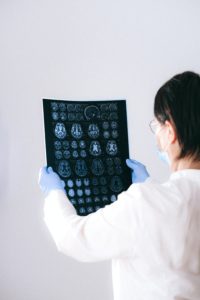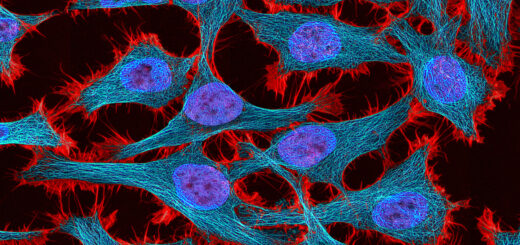The science of anxiety

Anxiety is a feeling of distress or uneasiness that everyone experiences from time to time. The feeling is your brain’s normal response to stress, uncertainty, or fear of danger. The short-term response stems from the body’s internal fight-or-flight system1 that activates whenever it senses danger and needs to go into survival mode.
The fear of danger can be real or perceived, and may be accompanied by worry or a sense of impending doom. Although it acts as a protective mechanism most of the time, chronic activation2 of this built-in “approach” or “retreat” system may lead to chronic anxiety or anxiety disorders.
The science of anxiety provides an insight into what goes on in the brain to trigger anxiety and how anxiety disorder develops as a result. A lot of it has to do with changes in activity in the amygdala3, the part of the brain’s limbic system that deals with emotions, arousal, and fear-related memories.
Anxiety vs anxiety disorders
It’s normal to worry or feel anxious when you are faced with a problem, have to make an important decision, or encounter a situation where you are under pressure to perform well, like a job interview or meeting your date’s parents for the first time. The feeling usually goes away once the situation passes, but when a person has an anxiety disorder4, those feelings don’t dissipate immediately. In fact, they worsen over time.
Anxiety disorders are chronic mental conditions that affect 40 million adults5 in the United States aged 18 and older each year (about 19.1% of the population). The five main types of anxiety disorders are generalized anxiety disorder (GAD)6, social anxiety disorder, phobias, obsessive-compulsive disorder (OCD), and post-traumatic stress disorder (PTSD). GAD is the most common and involves persistent worry over life events in general.
People affected by any of these disorders live in a constant state of worry or fear that interferes with daily functioning. They also have difficulty regulating these feelings or symptoms without drug treatment, behavioural therapy, or alternative therapies.
How anxiety affects the body
Anxiety affects the Central Nervous System (CNS) and other systems in the body. Different sensations or symptoms are triggered in these physical systems:
- Sense of doom, panic attacks7, headaches, irritability, trouble sleeping, or depression
- Shortness of breath
- Increased blood pressure, racing heartbeat/palpitations, or chest pain
- Stomach aches, nausea, or diarrhoea
- Muscle tension, pain, or fatigue
- Reduced sex drive or sexual function
What does anxiety feel like?
Doctors have identified a range of symptoms that help explain how it feels to have anxiety. Symptoms may depend on the type of anxiety, such as social anxiety8, which is characterized by an intense fear of being embarrassed or criticized. If you’re living with an anxiety condition, you may already be familiar with the following feelings or symptoms that interfere with your daily life:
Psychological
- Nervous, worried, or afraid
- Tense, uneasy, or on edge
- Fearful that something terrible is about to happen (even in the absence of danger)
- Morbid fear of impending doom, e.g., that you’re about to die
- Feeling detached
- Feeling like you’re losing control
Physical
- Chest tightness or pain
- Feeling as if you’re choking or out of breath
- Feeling excessively sweaty or cold
- Shaking or trembling
- Numbness or tingling sensations
- Feeling dizzy or as if you’re about to faint
- Feeling tired or fatigued, e.g., due to trouble sleeping
The rational vs emotional brain
Cognitive and psychological changes are already happening before you experience the effects of anxiety. By then, stress hormones such as cortisol and adrenaline, have already flooded the brain. Activities are also happening in the amygdala9, hypothalamus, and hippocampus in the limbic system. These are areas of the brain that play a key role in anxiety.

Brain scan. Image by Anna Shvets (CC BY 2.0)
Scientists believe that anxiety stems from how the areas of the cognitive and emotional brain interact. The prefrontal cortex (PFC) area of the brain helps process information for rational decision-making, whilst the emotional region of the brain, called the amygdala, detects threats or dangers and triggers fear-related behaviours10 in response.
These are normal functions of the frontal lobe and amygdala in the limbic system. However, anxiety is thought to happen when signals from the emotional brain11 overpower the cognitive brain. The amygdala goes into a heightened arousal state when triggered and sends a message to the hypothalamus to initiate the fight-or-flight response.
Scientists believe that anxiety stems from how the areas of the cognitive and emotional brain interact. The prefrontal cortex (PFC) area of the brain helps process information for rational decision-making, whilst the emotional region of the brain, called the amygdala, detects threats or dangers and triggers fear-related behaviours12 in response.
These are normal functions of the frontal lobe and amygdala in the limbic system. However, anxiety is thought to happen when signals from the emotional brain13 overpower the cognitive brain. The amygdala goes into a heightened arousal state when triggered and sends a message to the hypothalamus to initiate the fight-or-flight response.
Being in a constant state of worry or fear also causes stress hormones to continuously flood the brain, causing the brain’s threat detector to become stuck in “survival mode” due to over-vigilance. The brain learns to hold onto thoughts or memories that trigger anxiety and this can interfere with rational decision-making, making it difficult for people with anxiety disorders to go about their everyday lives.
For people with anxiety disorders, just about anything that the brain perceives as a threat can trigger a fight-or-flight reaction. Knowing that heightened activity in the emotional brain leads to an oversensitive response, it’s no surprise that apart from common triggers such as everyday life stressors, conflicts, or health issues. People with anxiety disorders may also be triggered by seemingly innocuous things like certain smells, sights, sounds, people, or places.
Can anxiety disorders be treated?
Treating anxiety early can help prevent anxiety disorders and other psychiatric disorders, such as depression or substance use disorders (SUDs).
Drug therapy and cognitive behavioural therapy are standard options for anxiety disorders. Doctors commonly prescribe anti-anxiety medications such as benzodiazepines and antidepressants, including selective serotonin reuptake inhibitors (SSRIs). Treatment is intended to manage symptoms and allow patients to go about their daily life —but unfortunately, there is currently no cure for most anxiety disorders.
Aside from drug therapy, some patients also benefit from Transcranial Magnetic Stimulation (TMS), psychodynamic therapy, and hypnotherapy, which have been shown to have some success at alleviating pathological anxiety. For general anxiety, alternative therapies include stress management and relaxation techniques, such as meditation, mindfulness, yoga, and art.
References
- https://www.cci.health.wa.gov.au/-/media/CCI/Mental-Health-Professionals/Anxiety/Anxiety—Information-Sheets/Anxiety-Information-Sheet—01—What-is-Anxiety.pdf
- https://www.health.harvard.edu/staying-healthy/understanding-the-stress-response
- https://www.ncbi.nlm.nih.gov/pmc/articles/PMC3684250/
- https://www.sunshinebehavioralhealth.com/resources/mental-health-resources-anxiety-disorder-addiction/
- https://nami.org/About-Mental-Illness/Mental-Health-Conditions/Anxiety-Disorders
- https://www.nimh.nih.gov/health/publications/generalized-anxiety-disorder-gad
- https://www.nhs.uk/mental-health/conditions/panic-disorder/
- https://www.beyondblue.org.au/the-facts/anxiety/types-of-anxiety
- https://www.intechopen.com/chapters/55211
- https://www.pnas.org/doi/10.1073/pnas.1219167110
- https://www.brainfacts.org/diseases-and-disorders/mental-health/2018/what-part-of-the-brain-deals-with-anxiety-what-can-brains-affected-by-anxiety-tell-us-062918
- https://www.pnas.org/doi/10.1073/pnas.1219167110
- https://www.brainfacts.org/diseases-and-disorders/mental-health/2018/what-part-of-the-brain-deals-with-anxiety-what-can-brains-affected-by-anxiety-tell-us-062918






